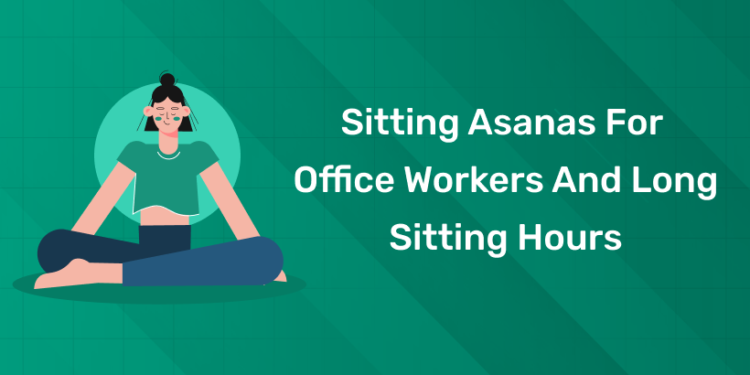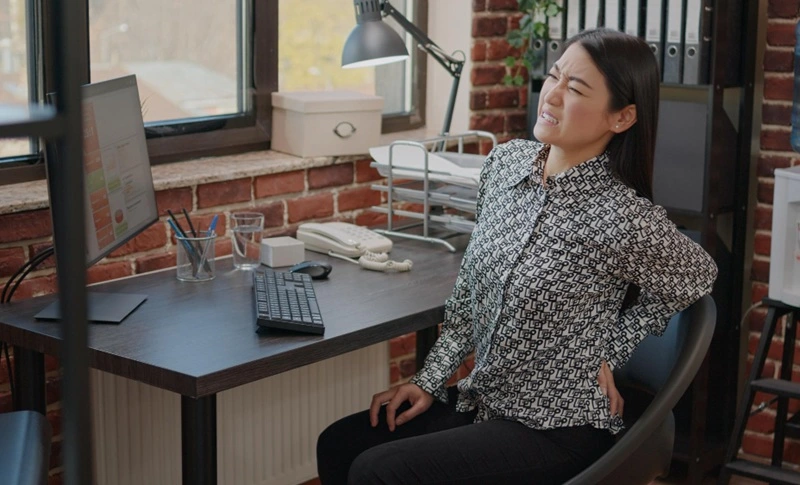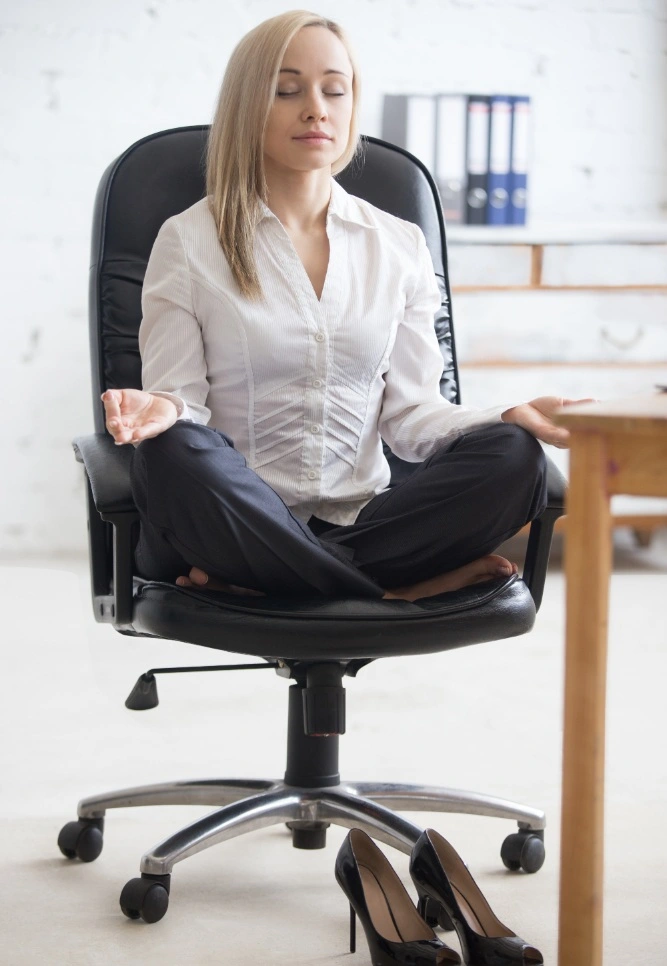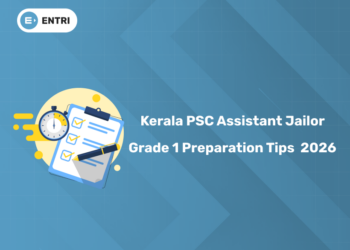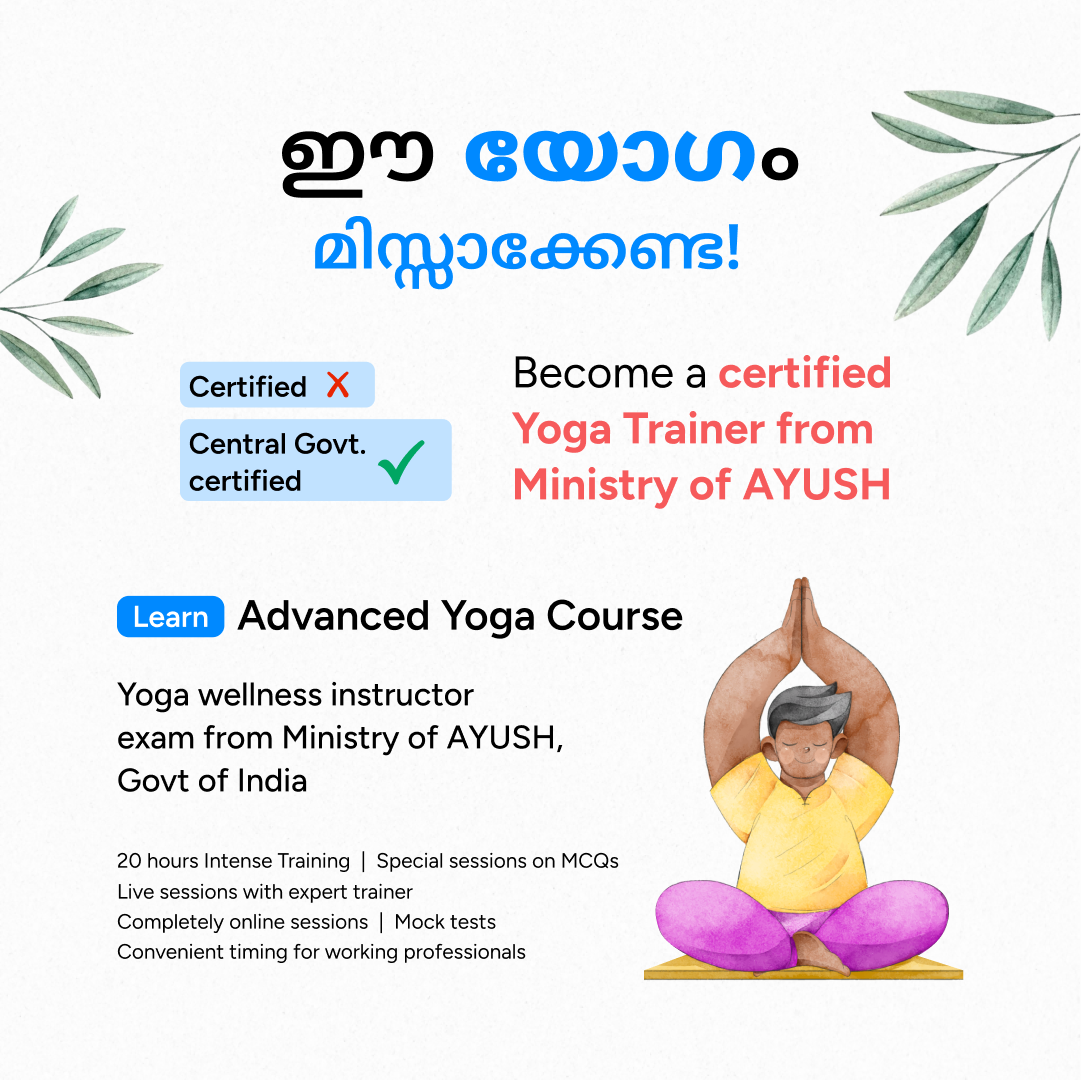Table of Contents
If you spend most of your day seated, at a desk, in meetings, or driving between appointments, your body is telling a story. Stiff hips, a tight lower back, sore shoulders and foggy thinking are all common chapters. The good news: you don’t need a long yoga class or a special mat to change the ending. With short, intentional sitting asanas and breath practices woven through your day, you can undo much of the harm of prolonged sitting, restore mobility, and sharpen your concentration, all from your chair.
In this blog, you’ll find: why sitting hurts, how seated yoga helps, step-by-step instructions for the best sitting asanas, short practice templates you can do in meeting breaks, breathing practices, ergonomics tips, and guidance for aspiring yoga teachers who want to lead desk-friendly classes. I’ll also explain how Entri’s Yoga TTC course can help you teach these practices safely and confidently.
Get Confident! Join Our Yoga Teacher Training Course!
Why sitting for long hours is a health problem
Humans are made to move. When we sit for long periods we lock joints and shorten muscles that expect movement. Over time, this manifests as:
- Tight hip flexors and hamstrings (making standing and walking uncomfortable).
- Rounded shoulders and forward head posture from screens and laptops.
- Reduced circulation in the legs and feet.
- Stiff thoracic spine (upper back) and limited rotation, which makes simple daily motions feel heavy.
- Mental fog and decreased alertness due to poor breath habits and stagnant circulation.
Research and clinic experience show that long sitting raises the risk of metabolic stagnation and back problems , but the single most practical countermeasure is frequent, short movement. Even five minutes of intentional movement every hour reduces stiffness and restores energy. That’s the sweet spot where sitting asanas shine: they are doable, discreet and highly effective.
The goals of sitting asanas
1: Which of these is the primary goal of yoga practice?
A good desk yoga practice aims for four things:
- Mobility: Gentle movement that lubricates the spine, hips and shoulders.
- Posture: Strengthening and cues that encourage an upright, comfortable seated position.
- Circulation: Movements that stimulate blood flow to the brain, hands and legs.
- Calm: Breath practices that reduce stress and reset focus between tasks.
You will not become a contortionist at your desk, and you don’t need to be. What you will gain is less pain, clearer thinking and the ability to remain productive without the body complaining.
Become a Certified Yoga Instructor
Yoga Teacher Training Course by Entri App: Master authentic yoga techniques, earn certification, and build a successful career as a professional yoga instructor.
Join Now!Core sitting asanas, step-by-step
Below are the most practical, high-impact sitting asanas you can use during the workday. I’ll give instructions, common mistakes and simple modifications.
1. Sukhasana, Easy Seated Pose (centering and breathing)
How to do it: Sit cross-legged on the floor, or pop your feet up on the edge of a chair, and feel the floor beneath you. Keep your spine straight and your shoulders relaxed, with your hands resting on your thighs or knees.
Practice: Close your eyes and breathe naturally for a minute or two – 1-3 minutes is a good starting point. Take note of how your breath can lengthen your spine.
Why it helps: This pose will ground your nervous system, remind you of good posture (even when you’re sitting!), and get you ready for some deeper breathwork.
Tip: If crossing your legs is a no-go, try sitting with your feet flat on the floor and your hands rested on your thighs.
2. Seated Cat-Cow (getting your spine moving)
How to do it: Sit on the edge of a chair, with your feet hip-width apart and your hands on your knees. As you inhale, lift your chest and gently arch your back – think “cow”! As you exhale, round your spine and tuck your chin in – think “cat”.
Practice: Sway slowly back and forth for 8-12 repetitions, keeping your movements linked to your breath.
Why it helps: This pose will loosen up your whole spine, help reduce stiffness from slumping in a chair, and keep you flexible.
Common mistake: Don’t be tempted to collapse your chest in the “cow” position – keep your front body open and your lower back safe.
3. Ardha Matsyendrasana (Seated Half Twist – chair friendly)
How to do it: Sit with your feet flat on the floor. As you inhale, lengthen your spine. As you exhale, twist from the base of your spine and let your chest lead the way – use the chair back or armrest for support if you need it. Hold for 4-6 breaths on each side.
Why it helps: This pose will release tension in your lower back, remind you to stand up straight, and even help your digestion after a meal.
Modification: If twisting is a challenge, try keeping your hands on your thighs and focus on taking deep breaths rather than pushing for range.
4. Seated Side Stretch (opening up your sides)
How to do it: Sit with your back straight, inhale and lift your right arm up overhead. As you exhale, lean to one side and keep your left sit bone grounded – breathe 4-6 times, then repeat on the other side.
Why it helps: This pose will open up your ribs and intercostal muscles, give your breathing a boost, and ease tension along your side body.
Tip: Keep your neck nice and neutral – avoid collapsing towards your ribcage.
5. Seated Forward Fold (chair Paschimottanasana)
How to do it: Sit right on the edge of your chair, inhale to lift and lengthen your spine, then exhale and hinge forward from your hips, letting your upper body rest on your thighs or knees. If your hamstrings are tight, bend your knees a bit.
Why it helps: This pose will calm your nervous system, provide a gentle stretch for your lower back and hamstrings, and just generally feel nice.
Caution: Take it slow and keep your spine long – don’t round forward too aggressively.
6. Figure-Four Seated (hip opener for office workers)
How to do it: Cross your right ankle over your left thigh, with your right foot flexed. Keep your spine long and hinge forward just a bit – hold for 30-60 seconds. Repeat on the other side.
Why it helps: This pose will open up your outer hip and glutes, which are often tight from sitting all day.
Modification: If this pose is uncomfortable, try doing a standing figure-four against a wall, or do the same thing without bending forward – just have your ankle on the opposite knee.
7. Shoulder Rolls and Eagle Arms (upper back release)
How (shoulder rolls): Slowly roll shoulders back five times, then forward five times.
How (eagle arms): Wrap right arm under the left at the elbow, lift elbows and draw forearms away from the face. Hold 20–30 seconds per side.
Why it helps: Releases tightness between the shoulder blades and opens the chest , crucial for counteracting screen shoulders.
8. Wrist and Forearm Mobility
How: Extend one arm in front, palm up; use the other hand to gently pull back the fingers. Then flip the palm down and repeat. Rotate wrists in both directions.
Why it helps: Essential for keyboard users , prevents wrist strain and early carpal tunnel symptoms.
9. Ankle Circles and Toe Pumps
How: Lift one foot and draw large circles with the ankle. Then point and flex the foot for 20–30 seconds. Repeat other side.
Why it helps: Stimulates circulation in the lower legs, reduces swelling and keeps feet awake.
10. Mini Meditation / Mindful Breath
How: Sit tall, close your eyes, and follow the breath for 1–3 minutes. Use a simple count: inhale 4, exhale 6.
Why it helps: Resets the nervous system, reduces stress hormones and improves focus for the next task.
Three practical sequences you can use at work
Here are ready-to-use sequences. Use them as is, or adapt to the time you have.
5-Minute Reset (perfect between meetings)
- Sukhasana + grounding breath, 1 minute
- Neck rolls, 30 seconds
- Seated Cat–Cow, 1 minute (8 breaths)
- Wrist stretches, 30 seconds each side
- Mini meditation (counted breath), 1 minute
10-Minute Midday Flow (recharges energy)
- Sukhasana + diaphragmatic breathing, 1 minute
- Seated Side Stretch, 1 minute (30s each side)
- Seated Twist, 1 minute (30s each side)
- Figure-Four seated, 2 minutes (1 min each side)
- Seated Forward Fold, 2 minutes
- Anulom Vilom (alternate nostril breathing), 2 minutes
15-Minute Deep Release (after a long meeting or end of day)
- Sukhasana + long breath, 1 minute
- Neck & shoulder release with eagle arms, 2 minutes
- Seated Cat–Cow, 2 minutes
- Seated Twist, 2 minutes (each side)
- Figure-Four seated + gentle forward fold, 3 minutes total
- Ankle circles + wrist mobility, 1 minute
- Mini guided relaxation, 2 minutes
Breathwork you can do sitting (quick and powerful)
Breath is the fastest route back to calm.
- Diaphragmatic Breathing: Place one hand on belly. Inhale slowly to fill the belly; exhale fully. Repeat 8–10 times.
- Box Breathing (4-4-4-4): Inhale 4 counts , hold 4 , exhale 4 , hold 4. Repeat 6 cycles. Great before presentations.
- Anulom Vilom (Alternate Nostril): Sit tall. Close right nostril with thumb and inhale left; close left with ring finger and exhale right. Continue 8–12 rounds. Balances nervous system and clears mental clutter.
Practice breathwork for 2–5 minutes and you’ll feel immediate clarity.
Become a Certified Yoga Instructor
Yoga Teacher Training Course by Entri App: Master authentic yoga techniques, earn certification, and build a successful career as a professional yoga instructor.
Join Now!Ergonomics + lifestyle habits that amplify the benefits
Yoga at the desk helps , but pairing it with basic ergonomic and lifestyle changes makes the gains permanent.
- Chair height: Hips slightly higher than knees is ideal. Use a cushion if chair is too low.
- Screen level: Top of screen at eye height to avoid forward head posture.
- Keyboard & mouse positioning: Keep them close to the body to avoid reaching and shoulder strain.
- Movement breaks: Stand and walk for 2–3 minutes every 45–60 minutes. Put a reminder on your calendar if needed.
- Hydration & eye breaks: Drink water often; follow the 20-20-20 rule for eyes (every 20 minutes look at something 20 feet away for 20 seconds).
These small adjustments reduce cumulative stress on the body and let your sitting asanas be more effective.
For aspiring yoga teachers: how to design and market desk-yoga sessions
If you want to teach desk yoga , to colleagues, corporate clients or community groups , approach it as a practical service.
- Start with education: Briefly explain why long sitting matters and what the session will achieve. People buy outcomes: less pain, more focus, energy.
- Keep language simple: Use clear, non-Sanskrit instructions in group settings. Describe sensations and cues.
- Offer tiers: 10-minute micro sessions for daily reminders, 30-minute weekly wellness sessions, and a 6-week program that builds habit.
- Provide handouts: One-page sequences and image cues help retention.
- Measure outcomes: Ask participants to rate neck/back pain and energy before and after a 4-week program. Data helps sell repeat bookings.
- Business basics: Package sessions for HR teams, parent groups, or teachers’ associations , highlight improved productivity and reduced sick days as benefits.
A professional teaching pathway, like Entri’s Yoga TTC Course , helps you build safe sequences, understand anatomy, and learn class management and client acquisition. The TTC gives depth (alignment, anatomy, practicum) so your desk yoga offering is credible and sustainable.
How Entri’s Yoga TTC helps you teach desk-friendly yoga confidently
Entri’s Yoga Teacher Training Course is built for modern teachers. If your goal is to lead workplace wellness or community classes, the TTC supports you in these areas:
- Anatomy & biomechanics: Learn why the hips tighten and which cues safely restore range.
- Sequencing for special populations: Design classes for office workers, older adults and people with limited mobility.
- Teaching methodology: Learn how to give clear, inclusive instructions and progressive variations.
- Practicum & feedback: Real teaching hours and mentor feedback sharpen your delivery.
- Career guidance: How to price sessions, approach corporate clients and create wellness packages.
If you love the desk practices in this article and want to make a living teaching them, a structured TTC will give you the tools and confidence to do it well.
Realistic expectations and progress tracking
Change is gradual, not instant. Noticeable improvements often show up in 2–6 weeks if you do micro-breaks 2–3 times a day.
Track progress with simple measures:
- Pain scale (0–10) for neck, shoulder and lower back weekly.
- Minutes of uninterrupted focus or reduction in afternoon slump.
- Increased range of motion (e.g., deeper forward fold, easier hip cross).
Celebrate small wins: fewer headaches, calmer mood or easier stair climbing.
Key takeaways:
- Prolonged sitting creates predictable patterns of stiffness and poor posture.
- Short, frequent sitting asanas (5–15 minutes) are super effective for office workers.
- Focus on spinal mobility, hip opening, shoulder release, wrist care and breath.
- Combine desk yoga with ergonomic practices and short walking breaks for best results.
- Aspiring teachers can package desk yoga as workshops and corporate wellness offerings.
- Training like Entri’s Yoga TTC gives you the anatomy, sequencing and teaching skills to lead safe, professional sessions.
Conclusion
The most powerful yoga is the simple, steady practice that fits your life. Desk yoga is not a gimmick; it’s practical self-care for our times. If you can commit to small movement breaks every day, you’ll not only feel better physically but also gain the calm and focus to make your work flow more easily.
If you’d like help putting together a 4-week plan, a short workshop script for your office or mentoring as you move from practice to teaching, I’d recommend checking out Entri’s Yoga TTC for structured learning and career support. Teach what you learn and keep your practice personal. Start tomorrow: when you feel your shoulders creep up, take two minutes to breathe, twist and release. Your body will thank you.
Become a Certified Yoga Instructor
Yoga Teacher Training Course by Entri App: Master authentic yoga techniques, earn certification, and build a successful career as a professional yoga instructor.
Join Now!Frequently Asked Questions
What are the best sitting asanas for office workers?
Some of the best sitting asanas include Sukhasana (Easy Pose), Ardha Matsyendrasana (Seated Twist), Vajrasana (Thunderbolt Pose), and Baddha Konasana (Butterfly Pose). These poses relieve stiffness and improve posture.
How can yoga help people with long sitting hours?
Yoga helps counteract the negative effects of prolonged sitting by stretching tight muscles, improving blood flow, and correcting posture. It also reduces stress and improves concentration.
Can I do yoga in my office chair?
Yes. Simple chair yoga poses like seated spinal twist, neck rolls, and shoulder shrugs can easily be performed at your desk to release tension and improve mobility.
How long should I practice yoga if I sit for 8 hours a day?
Just 10–15 minutes of daily yoga practice can help you stay active, reduce stiffness, and maintain spinal health even if you sit for long hours.
Is it okay to do sitting asanas immediately after work?
Yes. Practising yoga after work helps your body relax, improves blood circulation, and relieves fatigue caused by sitting all day.
Do I need a yoga mat to do sitting asanas?
Not necessarily. You can perform most sitting asanas on a chair or even while seated on the floor with a cushion, as long as your posture is stable and comfortable.
Can beginners try sitting yoga poses?
Absolutely. Sitting asanas are gentle and beginner-friendly. They help develop flexibility and awareness, making them ideal for people new to yoga.
Can yoga improve my focus at work?
Yes. Regular practice of sitting asanas and breathing exercises (like Anulom Vilom and Bhramari Pranayama) improves mental clarity, focus, and emotional balance, crucial for long work hours.
How can Entri’s Yoga TTC course help aspiring yoga teachers?
Entri’s Yoga TTC course offers comprehensive yoga teacher training with live classes, expert mentors, and placement guidance, helping you master both practical yoga and teaching methodologies to build a professional career in yoga


